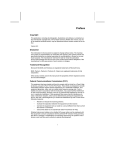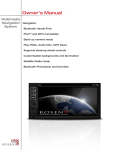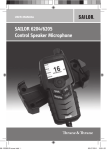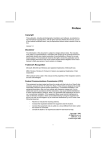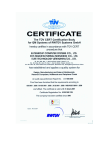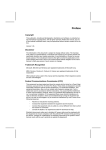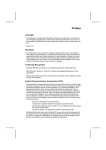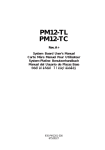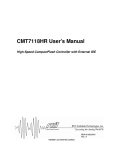Download Preface
Transcript
Preface Copyright This publication, including all photographs, illustrations and software, is protected under international copyright laws, with all rights reserved. Neither this manual, nor any of the material contained herein, may be reproduced without written consent of the author. Version 1.0 Disclaimer The information in this document is subject to change without notice. The manufacturer makes no representations or warranties with respect to the contents hereof and specifically disclaims any implied warranties of merchantability or fitness for any particular purpose. The manufacturer reserves the right to revise this publication and to make changes from time to time in the content hereof without obligation of the manufacturer to notify any person of such revision or changes. Trademark Recognition Microsoft, MS-DOS and Windows are registered trademarks of Microsoft Corp. MMX, Pentium, Pentium-II, Pentium-III, Celeron are registered trademarks of Intel Corporation. Other product names used in this manual are the properties of their respective owners and are acknowledged. Federal Communications Commission (FCC) This equipment has been tested and found to comply with the limits for a Class B digital device, pursuant to Part 15 of the FCC Rules. These limits are designed to provide reasonable protection against harmful interference in a residential installation. This equipment generates, uses, and can radiate radio frequency energy and, if not installed and used in accordance with the instructions, may cause harmful interference to radio communications. However, there is no guarantee that interference will not occur in a particular installation. If this equipment does cause harmful interference to radio or television reception, which can be determined by turning the equipment off and on, the user is encouraged to try to correct the interference by one or more of the following measures: − − − − Reorient or relocate the receiving antenna. Increase the separation between the equipment and the receiver. Connect the equipment onto an outlet on a circuit different from that to which the receiver is connected. Consult the dealer or an experienced radio/TV technician for help. Shielded interconnect cables and a shielded AC power cable must be employed with this equipment to ensure compliance with the pertinent RF emission limits governing this device. Changes or modifications not expressly approved by the system's manufacturer could void the user's authority to operate the equipment. Declaration of Conformity This device complies with part 15 of the FCC rules. Operation is subject to the following conditions: − − This device may not cause harmful interference, and This device must accept any interference received, including interference that may cause undesired operation. Canadian Department of Communications This class B digital apparatus meets all requirements of the Canadian Interferencecausing Equipment Regulations. Cet appareil numérique de la classe B respecte toutes les exigences du Réglement sur le matériel brouilieur du Canada. About the Manual The manual consists of the following: Chapter 1 Describes features of the motherboard, and provides a shipping checklist. Introducing the Motherboard Go to ⇒ page 1 Chapter 2 Describes installation of motherboard components. Installing the Motherboard Go to ⇒ page 7 Chapter 3 Provides information on using the BIOS Setup Utility. Using BIOS Go to ⇒ page 20 Chapter 4 Describes the motherboard software. Using the Motherboard Software Go to ⇒ page 43 ii TABLE OF CONTENTS Preface i CHAPTER 1 1 Introducing the Motherboard 1 Introduction ...................................................................................................1 Features........................................................................................................2 Choosing a Computer Case .........................................................................4 Motherboard Components............................................................................5 CHAPTER 2 7 Installing the Motherboard 7 Safety Precautions .......................................................................................7 Quick Guide ..................................................................................................7 Installing the Motherboard in a Case ...........................................................8 Checking Jumper Settings ...........................................................................8 Setting Jumpers...................................................................................................8 Checking Jumper Settings ..................................................................................9 Jumper Settings...................................................................................................9 Connecting Case Components ..................................................................10 Front Panel Connector ......................................................................................11 Installing Hardware.....................................................................................12 Installing Memory Modules .............................................................................12 Installing a Hard Disk Drive/CD-ROM ...........................................................13 Installing Add-on Cards....................................................................................15 Connecting Optional Devices...........................................................................16 Connecting I/O Devices..............................................................................19 CHAPTER 3 20 Using BIOS 20 About the Setup Utility................................................................................20 The Standard Configuration .............................................................................20 Starting Setup....................................................................................................21 Updating the BIOS ...........................................................................................22 Using BIOS .................................................................................................23 Standard CMOS Setup......................................................................................23 Advanced BIOS Features .................................................................................25 Advanced Chipset Features Option..................................................................27 Integrated Peripherals .......................................................................................31 Power Management Setup................................................................................35 PNP/PCI Configurations ..................................................................................38 PC Health Status ...............................................................................................39 Frequency/Voltage Control...............................................................................40 Load Fail-Safe Defaults Option .......................................................................41 iii Load Optimized Defaults Option .....................................................................41 Set Supervisor/User Password..........................................................................41 Save & Exit Setup Option ................................................................................42 Exit Without Saving..........................................................................................42 CHAPTER 4 43 Using the Motherboard Software 43 About the Software CD-ROM.....................................................................43 Auto-installing under Windows 98/ME/2000/XP ........................................43 Running Setup ..................................................................................................44 Manual Installation......................................................................................46 Utility Software Reference..........................................................................46 iv Chapter 1 Introducing the Motherboard Introduction Thank you for choosing the C3VCM6 motherboard. C3VCM6 motherboard carries a Mini Micro ATX form factor of 170 x 170 mm. This motherboard supports C3 processors with system bus speeds up to 133MHz. This motherboard features the latest VIA CLE266CE: VT8623CE Northbridge & VT8235CD Southbridge chipsets. The VT8623CE provides superior performance between the CPU, DRAM, VLink bus and internal AGP 4X graphics controller bus with pipelined, burst and concurrent operation. This motherboard supports one 2.5V 184-pin DDR SDRAM DIMM up to 1GB. The VT8623CE Northbridge also integrates a VIAdesigned 128-bit graphics accelerator into the chip, which brings mainstream graphics performance to the Value PC with leading-edge 2D, 3D and DVD video acceleration into a cost effective package. The VT8623CE host system controller supports a high speed 8-bit 66 MHz Quad Data Transfer interconnect (V-Link) to the VT8235CD Southbridge. The VT8235CD is a high integration, high performance, power-efficient that supports Intel and non-Intel based processor. The Southbridge supports the UltraDMA-133, 100, 66, and 33 standards to allow data transfer rates up to 133 MB/s. It also includes Universal Serial Bus controller that is USB v2.0/1.1 and Universal HCI v2.0/1.1 compliant, integrated Fast Ethernet Controller with 1/10/100 Mbit capability, integrated PCI support, and AC’97 digital audio controller. There is an advanced full set of I/O ports in the rear panel, including PS/2 mouse and keyboard connectors, VGA port, COM1, LPT, and four USB ports, one optional LAN port, and audio jacks for microphone, line-in (optional), and line-out. Features Processor Chipset The motherboard supports the following features: • Accommodates VIA C3 processor • Supports 133MHz CPU front-side bus (FSB) • Five outstanding transactions (four In-Order Queue (IOQ) plus one output latch) The VT8623CE Northbridge (NB) and VT8235CD Southbridge (SB) chipsets are based on an innovative and scalable architecture with proven reliability and performance. A few of the chipset’s advanced features are: Chipset VT8623CE NB VT8235CD SB Features Supports 66MHz V-Link Host interface with total bandwidth of 266 MB/s Supports DDR266/200 DDR SDRAM and PCI133/100 SDR SDRAM memory types Integrated 2D/3D AGP Graphics Core Optimized Shared Memory Architecture (SMA). Supports ACP 1.0B and PCI Bus Power Management 1.1 compliant USB v2.0/1.1 and USB v1.1 and Universal Host Controller Interface (UHCI) v2.0/1.1 compliant Supports Dual channel UltraDMA133/100/66/33 master mode EIDE controller Compliant with PCI 2.2 specification Highly efficient V-Link arbitration with minimum overhead. Integrated Fast Ethernet Controller with 1/10/100 Mbit capability Direct Sound Ready AC’97 Digital Audio Controller Memory The motherboard accommodates 2.5V DDR configurations. It can support one unbuffered 184-pin slot with a maximum memory size of 1Gb. AC’97 Audio Codec • • Expansion Options Compliant with AC’97 2.3 specification 18-bit stereo full-duplex CODEC with independent and variable sampling rate • 3.3V digital, 5V analog power supply • Low Power consumption management The motherboard comes with the following expansion options: • One 32-bit PCI slots • Two IDE connectors which supports four enhanced IDE drives The C3VCM6 supports Ultra DMA bus mastering with transfer rates of 33/66/100/133 MB/sec. 2 Integrated I/O Onboard LAN (optional) BIOS Firmware The motherboard has a full set of I/O ports and connectors: • Two PS/2 ports for mouse and keyboard • One serial port • One VGA port • One parallel port • One LAN port • Four USB ports • Audio jacks for microphone, line-in (optional) and line-out The onboard LAN provides the following features: • Integrated Fast Ethernet MAC, Physical chip and transceiver in one chip • Supports 10Mb/s and 100Mb/s operation • Supports ACPI, PCI power management • Compliant to PC99/PC2001standard • Supports Wake-On-LAN(WOL) function and remote wake-up This motherboard uses Award BIOS that enables users to configure many system features including the following: • Power management • Wake-up alarms • CPU parameters and memory timing • CPU and memory timing The firmware can also be used to set parameters for different processor clock speeds. 3 Choosing a Computer Case There are many types of computer cases on the market. The motherboard complies with the specifications for the Mini Micro ATX system case. Some features on the motherboard are implemented by cabling connectors on the motherboard to indicators and switches on the system case. Ensure that your case supports all the features required. The motherboard can support two enhanced IDE drives. Ensure that your case has sufficient power and space for all the drives that you intend to install. Most cases have a choice of I/O templates in the rear panel. Make sure that the I/O template in the case matches the I/O ports installed on the rear edge of the motherboard. This motherboard has a Mini Micro ATX form factor of 170 x 170 mm. Choose a case that accommodates this form factor. 4 Motherboard Components “*” stands for optional components. 5 Table of Motherboard Components Label ATX1 AUDIO1 AUXIN1* CASFAN1* COM2 CPU CPUFAN1 DIMM1 FLLED IDE1 IDE2 IR1* JP1 JP3 PANEL1 PCI1 SPDIFO1 USB3 Component Standard 20-pin ATX power connector Front panel audio header Auxiliary in header Case fan connector Onboard serial port header VIA C3 processor CPU cooling fan connector One 184-pin DDR DIMM slot Front LAN LED th Primary IDE connector (the 20 pin exists, stands for VCC) th Secondary IDE connector (the 20 pin exists, stands for VCC) Infrared header Clear CMOS jumper BIOS protect jumper Front panel switch/LED header 32-bit add-on card slot SPDIF out header Front Panel USB header “*” stands for optional components This concludes Chapter 1. The next chapter explains how to install the motherboard. 6 Chapter 2 Installing the Motherboard Safety Precautions Follow these safety precautions when installing the motherboard: • • • • Wear a grounding strap attached to a grounded device to avoid damage from static electricity. Discharge static electricity by touching the metal case of a safely grounded object before working on the motherboard. Leave components in the static-proof bags they came in. Hold all circuit boards by the edges. Do not bend circuit boards. Quick Guide This Quick Guide suggests the steps you can take to assemble your system with the motherboards. The following table provides a reference for installing specific components: Locating Motherboard Components Go to page 4 Installing the Motherboard in a Case Go to page 8 Setting Jumpers Go to page 8 Installing Case Components Go to page 9 Installing Memory Go to page 12 Installing an HDD and CD-ROM Drive Go to page 12 Installing Add-on Cards Go to page 15 Connecting Optional Devices Go to page 16 Connecting Peripheral (I/O) Devices Go to page 19 Installing the Motherboard in a Case Refer to the following illustration and instructions for installing the motherboard in a case: This illustration shows an example of a motherboard being installed in a tower-type case: Note: Do not overtighten the screws as this can stress the motherboard. Most system cases have mounting brackets installed in the case, which correspond to the holes in the motherboard. Place the motherboard over the mounting brackets and secure the motherboard onto the mounting brackets with screws. Ensure that your case has an I/O template that supports the I/O ports and expansion slots on your motherboard. Checking Jumper Settings This section explains how to set jumpers for correct configuration of the motherboard. Setting Jumpers Use the motherboard jumpers to set system configuration options. Jumpers with more than one pin are numbered. When setting the jumpers, ensure that the jumper caps are placed on the correct pins. The illustrations below show a 2-pin jumper. When the jumper cap is placed on both pins, the jumper is SHORT. If you remove the jumper cap, or place the jumper cap on just one pin, the jumper is OPEN. Short This illustration shows a 3-pin jumper. Pins 1 and 2 are SHORT. 1 2 3 Open 8 Checking Jumper Settings The following illustration shows the location of the motherboard jumpers. Pin 1 is labeled. Jumper Settings Jumper Type JP1 3-pin Description Setting (default) Clear CMOS 1-2: NORMAL 2-3: CLEAR Before clearing the CMOS, make sure to turn the system off. JP3 3-pin BIOS Protect 1 1-2: DISABLE 2-3: ENABLE 9 1 JP1 JP3 Connecting Case Components After you have installed the motherboard into a case, you can begin connecting the motherboard components. Refer to the following: 1. 2. 3. 4. Connect the CPU cooling fan cable to CPUFAN1. Connect the case cooling fan connector to CAFAN1 (optional). Connect the case switches and indicator to PANEL1. Connect the Pentium 4 processor auxiliary case power supply connector to ATX1. CPUFAN1/CASFAN1(optional): FAN Power Connectors Pin 1 2 3 Signal Name Function GND +12V Sense System Ground Power +12V Sensor ATX1: ATX 20-pin Power Connector Pin Signal Name Pin Signal Name 1 2 3 4 5 6 7 8 9 10 +3.3V +3.3V Ground +5V Ground +5V Ground PWRGD +5VSB +12V 11 12 13 14 15 16 17 18 19 20 +3.3V -12V Ground PS ON# Ground Ground Ground -5V +5V +5V 10 Front Panel Connector The front panel connector (PANEL1) provides a standard set of switch and LED connectors commonly found on ATX or micro-ATX cases. Refer to the table below for information: Pin 1 Signal Function Pin Signal Function MSG LED [dual color or single color (+)] MSG LED [dual color or single color (-)] HD_LED_P Hard disk LED (+) 2 FP PWR/SLP 3 HD_LED_N Hard disk active LED (-) 4 FP PWR/SLP 5 7 9 RST_SW_N Reset Switch (-) Power Switch (+) Reset Switch (+) PWR_SW_N Power Switch (-) RSVD Reserved 6 8 10 PWR_SW_P RST_SW_P NC No pin Hard Drive Activity LED Connecting pins 1 and 3 to a front panel mounted LED provides visual indication that data is being read from or written to the hard drive. For the LED to function properly, an IDE drive should be connected to the onboard IDE interface. The LED will also show activity for devices connected to the SCSI (hard drive activity LED) connector. Power / Sleep / Message Waiting LED Connecting pins 2 and 4 to a single- or dual-color, front panel mounted LED provides power on/off, sleep, and message waiting indication. Reset Switch Supporting the reset function requires connecting pins 5 and 7 to a momentary-contact switch that is normally open. When the switch is closed, the board resets and runs POST. Power Switch Supporting the power on/off function requires connecting pins 6 and 8 to a momentary-contact switch that is normally open. The switch should maintain contact for at least 50 ms to signal the power supply to switch on or off. The time requirement is due to internal debounce circuitry. After receiving a power on/off signal, at least two seconds elapses before the power supply recognizes another on/off signal. 11 Installing Hardware Installing Memory Modules This motherboard accommodates 184-pin 2.5V unbuffered Double Data Rate (DDR) DIMM memory modules. This motherboard can support DDR266/200 (PC2100/PC1600) DDR SDRAM. The maximum memory size is 1GB. Do not remove any memory module from its antistatic packaging until you are ready to install it on the motherboard. Handle the modules only by their edges. Do not touch the components or metal parts. Always wear a grounding strap when you handle the modules. Installation Procedure Refer to the following to install the memory modules. 1. This motherboard supports unbuffered DDR SDRAM only. 2. Push the latches on each side of the DIMM slot down. 3. Align the memory module with the slot. The DIMM slots are keyed with notches and the DIMMs are keyed with cutouts so that they can only be installed correctly. 4. Check that the cutouts on the DIMM module edge connector match the notches in the DIMM slot. 5. Install the DIMM module into the slot and press it firmly down until it seats correctly. The slot latches are levered upwards and latch on to the edges of the DIMM. 6. Install any remaining DIMM modules. 12 Installing a Hard Disk Drive/CD-ROM This section describes how to install IDE devices such as a CD-ROM drive and hard disk drive SATA hard drive. About IDE Devices Your motherboard has a primary and secondary IDE channel interface (IDE1 and IDE2). Users please note that IDE1 and IDE2 both have the 20th pin that serves as VCC signal. An IDE ribbon cable supporting two IDE devices is bundled with the motherboard. If you want to install more than two IDE devices, get a second IDE cable and you can add two more devices to the secondary IDE channel. IDE devices have jumpers or switches that are used to set the IDE device as MASTER or SLAVE. Refer to the IDE device user’s manual. When installing two IDE devices on one cable, ensure that one device is set to MASTER and the other device is set to SLAVE. The documentation of your IDE device explains how to do this. Installing a Hard Disk Drive/CD-ROM This section describes how to install IDE devices such as a hard disk drive and a CD-ROM drive. Your motherboard has a primary IDE channel interface (IDE1). An IDE ribbon cable supporting two IDE devices is bundled with the motherboard. If you want to install more than two IDE devices, get a second IDE cable and you can add two more devices to the secondary IDE channel. You must orient the cable connector so that the pin 1 (color) edge of the cable corresponds to the pin 1 of the I/O port connector. IDE1: Primary IDE Connector The first hard drive should always be connected to IDE1. 13 IDE2: Secondary IDE The second drive on this controller must be set to slave mode. The configuration is the same as IDE1. You must orient the cable connector so that the pin 1 (color) edge of the cable corresponds to the pin 1 of the I/O port connector. IDE devices have jumpers or switches that are used to set the IDE device as MASTER or SLAVE. Refer to the IDE device user’s manual. When installing two IDE devices on one cable, ensure that one device is set to MASTER and the other device is set to SLAVE. The documentation of your IDE device explains how to do this. About UltraDMA This motherboard supports UltraDMA 66/100/133. UDMA is a technology that accelerates the performance of devices in the IDE channel. To maximize performance, install IDE devices that support UDMA and use 80-pin IDE cables that support UDMA 66/100/133. 14 Installing Add-on Cards The slots in this motherboard are designed to hold expansion cards and connect them to the system bus. Expansion slots are a means of adding or enhancing the motherboard’s features and capabilities. With these efficient facilities, you can increase the motherboard’s capabilities by adding hardware which performs tasks that are not part of the basic system. PCI Slots This motherboard is equipped with 1 standard PCI slot. PCI stands for peripheral Component Interconnect and is a bus standard for expansion cards, which for the most part, is a supplement of the older ISA bus standard. This PCI slot is designated as 32-bit. Note: Before installing an add-on card, check the documentation for the card carefully. If the card is not Plug and Play, you may have to manually configure the card before installation. Follow these instructions to install an add-on card: 1. 2. 3. Remove a blanking plate from the system case corresponding to the slot you are going to use. Install the edge connector of the add-on card into the expansion slot. Ensure that the edge connector is correctly seated in the slot. Secure the metal bracket of the card to the system case with a screw. Note: For some add-on cards, for example graphics adapters and network adapters, you have to install drivers and software before you can begin using the add-on card. 15 Connecting Optional Devices Refer to the following for information on connecting the motherboard’s optional devices: AUDIO1: Front Panel Audio header This header allows the user to install auxiliary front-oriented microphone and line-out ports for easier access. Pin Signal Name Function 1 2 3 4 5 6 AUD_MIC AUD_GND AUD_MIC_BIAS AUD_VCC AUD_FPOUT_R AUD_RET_R 7 HP_ON 8 9 10 KEY AUD_FPOUT_L AUD_RET_L Front Panel Microphone input signal Ground used by Analog Audio Circuits Microphone Power Filtered +5 V used by Analog Audio Circuits Right Channel Audio signal to Front Panel Right Channel Audio signal to Return from Front Panel Reserved for future use to control Headphone Amplifier No Pin Left Channel Audio signal to Front Panel Left Channel Audio signal Return from Front Panel 16 USB3: Front panel USB header The motherboard has four USB ports installed on the rear edge I/O port array. Additionally, some computer cases have USB ports at the front of the case. If you have this kind of case, use auxiliary USB header USB3 to connect the front-mounted ports to the motherboard. Pin Signal Name Function 1 2 3 4 5 6 7 8 9 10 VREG_FP_USBPWR0 VREG_FP_USBPWR0 USB_FP_P0USB_FP_P1USB_FP_P0+ USB_FP_P1+ GND GND KEY USB_FP_OC0 Front Panel USB Power Front Panel USB Power USB Port 0 Negative Signal USB Port 1 Negative Signal USB Port 0 Positive Signal USB Port 1 Positive Signal Ground Ground No pin Overcurrent signal Note: Please make sure that the USB cable has the same pin assignment as indicated above. A different pin assignment may cause damage or system hang-up. SPDIFO1: SPDIF out header This is an optional header that provides an S/PDIF (Sony/Philips Digital Interface) output to digital multimedia device through optical fiber or coaxial connector. Pin 1 2 3 4 Signal Name Function SPDIF +5VA KEY GND SPDIF digital output 5V analog power No pin Ground AUXIN1: Auxiliary In header (optional) This connector is an additional line-in audio connector. It allows you to attach a line-in cable when your rear line-in jack is set as line out port for 4-channel function. Pin 1 2 3 4 Signal Name Function AUX_L GND GND AUX_R AUX In left channel Ground Ground AUX In right channel 17 COM2: Onboard serial port header Connect a serial port extension bracket to this header to add a second serial port to your system. Pin Signal Name Function 1 2 3 4 5 6 7 8 9 10 DCDB SINB SOUTB DTRB GND DSRB RTSB CTSB RI KEY Data Carrier Detect Serial Input UART B Serial Output UART B Data Terminal Ready Ground Data Set Ready UART B Request to Send Clear to Send Ring Indicator No pin IR1: Serial infrared port (optional) The motherboard supports an Infrared (IR) data port. Infrared ports allow the wireless exchange of information between your computer and similarly equipped devices such as printers, laptops, Personal Digital Assistants (PDAs), and other computers. Pin Signal Name Function 1 2 3 4 5 6 Not assigned KEY +5V GND IRTX IRRX Not assigned No pin IR Power Ground IrDA serial output IrDA serial input FLLED: Front LAN LED Pin 1 2 3 4 Signal Name Function Power Key ACT LINK Front LAN LED power No pin LAN ACT Signal LAN LINK Signal 18 Connecting I/O Devices The backplane of the motherboard has the following I/O ports: PS/2 Mouse Use the upper PS/2 port to connect a PS/2 pointing device. PS/2 Keyboard Use the lower PS/2 port to connect a PS/2 keyboard. USB Ports Use the four USB ports to connect USB devices. LPT1 Use LPT1 to connect printers or other parallel communications devices. COM1 Use the COM ports to connect serial devices such as mice or fax/modems. COM1 is identified by the system as COM1/3. VGA Connect your monitor to the VGA port. LAN Port (optional) Connect an RJ-45 jack to the LAN port to connect your computer to the Network. Audio Ports Use the two audio ports to connect audio devices. The upper jack is for a stereo line-in signal. The lower jack is for a microphone. 19 Chapter 3 Using BIOS About the Setup Utility The computer uses the latest AMI BIOS with support for Windows Plug and Play. The CMOS chip on the motherboard contains the ROM setup instructions for configuring the motherboard BIOS. The BIOS (Basic Input and Output System) Setup Utility displays the system's configuration status and provides you with options to set system parameters. The parameters are stored in battery-backed-up CMOS RAM that saves this information when the power is turned off. When the system is turned back on, the system is configured with the values you stored in CMOS. The BIOS Setup Utility enables you to configure: • • • • Hard drives, diskette drives, and peripherals Video display type and display options Password protection from unauthorized use Power management features The settings made in the Setup Utility affect how the computer performs. Before using the Setup Utility, ensure that you understand the Setup Utility options. This chapter provides explanations for Setup Utility options. The Standard Configuration A standard configuration has already been set in the Setup Utility. However, we recommend that you read this chapter in case you need to make any changes in the future. This Setup Utility should be used: • • • • • when changing the system configuration when a configuration error is detected and you are prompted to make changes to the Setup Utility when trying to resolve IRQ conflicts when making changes to the Power Management configuration when changing the password or making other changes to the Security Setup Starting Setup The BIOS is immediately activated when you first turn on the computer. The BIOS reads system configuration in CMOS RAM and begins the process of checking out the system and configuring it through the power-on self test (POST). When these preliminaries are finished, the BIOS seeks an operating system on one of the data storage devices (hard drive, floppy drive, etc.). The BIOS launches the operating system and hands control of system operations to it. During POST, you can start the Setup program in one on two ways: 1. 2. By pressing Del immediately after switching the system on, or By pressing Del or pressing Ctrl+Alt+Esc when the following message appears briefly at the bottom of the screen during POST: TO ENTER SETUP BEFORE BOOT PRESS DEL KEY If the message disappears before you respond and you still wish to enter Setup, restart the system to try again by turning it OFF then ON or pressing the RESET button on the system case. You may also restart by simultaneously pressing Ctrl+Alt+Del. If you do not press the keys at the correct time and the system does not boot, an error message appears and you are again asked to: PRESS F1 TO CONTINUE, DEL TO ENTER SETUP Phoenix – AwardBIOS CMOS Setup Utility Standard CMOS Features Frequency/Voltage Control Advanced BIOS Features Load Fail-Safe Defaults Advanced Chipset Features Load Optimized Defaults Integrated Peripherals Set Supervisor Password Power Management Setup Set User Password PnP/PCI Configurations Save & Exit Setup Exit Without Saving PC Health Status ↑ ↓ → ← : Esc : Quit F10 : Save & Exit Setup Time, Date, Hard Disk Type . . . 21 Select Item BIOS Navigation Keys The BIOS navigation keys are listed below: Key Function Esc Exits the current menu ←↑↓→ +/–/PU/PD Scrolls through the items on a menu Modifies the selected field's values F10 Saves the current configuration and exits setup F1 Displays a screen that describes all key functions F5 Loads previously saved values to CMOS F6 Loads a minimum configuration for troubleshooting. F7 Loads an optimum set of values for peak performance Updating the BIOS You can download and install updated BIOS for this motherboard from the manufacturer's Web site. New BIOS provides support for new peripherals, improvements in performance, or fixes for known bugs. Install new BIOS as follows: 1. 2. 3. 4. 5. 6. 7. 8. If your motherboard has a BIOS protection jumper, change the setting to allow BIOS flashing. If your motherboard has an item called Firmware Write Protect in Advanced BIOS features, disable it. (Firmware Write Protect prevents BIOS from being overwritten.) Create a bootable system disk. (Refer to Windows online help for information on creating a bootable system disk.) Download the Flash Utility and new BIOS file from the manufacturer's Web site. Copy these files to the system diskette you created in Step 3. Turn off your computer and insert the system diskette in your computer's diskette drive. (You might need to run the Setup Utility and change the boot priority items on the Advanced BIOS Features Setup page, to force your computer to boot from the floppy diskette drive first.) At the A:\ prompt, type the Flash Utility program name and press <Enter>. Type the filename of the new BIOS in the “File Name to Program” text box. Follow the onscreen directions to update the motherboard BIOS. When the installation is complete, remove the floppy diskette from the diskette drive and restart your computer. If your motherboard has a Flash BIOS jumper, reset the jumper to protect the newly installed BIOS from being overwritten. 22 Using BIOS When you start the Setup Utility, the main menu appears. The main menu of the Setup Utility displays a list of the options that are available. A highlight indicates which option is currently selected. Use the cursor arrow keys to move the highlight to other options. When an option is highlighted, execute the option by pressing <Enter>. Some options lead to pop-up dialog boxes that prompt you to verify that you wish to execute that option. Other options lead to dialog boxes that prompt you for information. Some options (marked with a triangle ) lead to submenus that enable you to change the values for the option. Use the cursor arrow keys to scroll through the items in the submenu. In this manual, default values are enclosed in parenthesis. Submenu items are denoted by a triangle . Standard CMOS Setup In the Standard CMOS menu you can set the system clock and calendar, record disk drive parameters and the video subsystem type, and select the type of errors that stop the BIOS POST. Phoenix – AwardBIOS CMOS Setup Utility Standard CMOS Features Date (mm:dd:yy) Time (hh:mm:ss) IDE Primary Master IDE Primary Slave IDE Secondary Master IDE Secondary Slave Video Halt On [EGA/VGA] [All Errors] Base Memory Extended Memory Total Memory 640K 65535K 1024K ↑ ↓ → ← : Move Enter : Select F5:Previous Values Wed, Dec 10 2003 16 : 9 : 36 Item Help Menu Level Change the day, month, year and century. +/-/PU/PD:Value: F10: Save ESC: Exit F1:General Help F6:Fail-Safe Defaults F7:Optimized Defaults Date and Time The Date and Time items show the current date and time on the computer. If you are running a Windows OS, these items are automatically updated whenever you make changes to the Windows Date and Time Properties utility. 23 IDE Devices (None) Your computer has two IDE channels (Primary and Secondary) and each channel can be installed with one or two devices (Master and Slave). Use these items to configure each device on the IDE channel. Press <Enter> to display the IDE submenu: Phoenix – AwardBIOS CMOS Setup Utility IDE Primary Master IDE HDD Auto-Detection [Press Enter] IDE Primary Master Access Mode [Auto] [Auto] Capacity 0 MB Cylinder Head Precomp Landing Zone Sector 0 0 0 0 0 ↑ ↓ → ← : Move Enter : Select F5:Previous Values Item Help Menu Level To auto-detect the HDD’s size, head . . . on this channel +/-/PU/PD:Value: F10: Save ESC: Exit F1:General Help F6:Fail-Safe Defaults F7:Optimized Defaults IDE HDD Auto-Detection Press <Enter> while this item is highlighted to prompt the Setup Utility to automatically detect and configure an IDE device on the IDE channel. Note: If you are setting up a new hard disk drive that supports LBA mode, more than one line will appear in the parameter box. Choose the line that lists LBA for an LBA drive. IDE Primary/Secondary Master/Slave (Auto) Leave this item at Auto to enable the system to automatically detect and configure IDE devices on the channel. If it fails to find a device, change the value to Manual and then manually configure the drive by entering the characteristics of the drive in the items described below. Refer to your drive's documentation or look on the drive casing if you need to obtain this information. If no device is installed, change the value to None. Note: Before attempting to configure a hard disk drive, ensure that you have the configuration information supplied by the manufacturer of your hard drive. Incorrect settings can result in your system not recognizing the installed hard disk. Access Mode This item defines ways that can be used to access IDE hard disks such as LBA (Large Block Addressing). Leave this value at Auto and the system will automatically decide the fastest way to access the hard disk drive. Press <Esc> to return to the Standard CMOS Features page. 24 Video (EGA/VGA) This item defines the video mode of the system. Halt On (All Errors) This item defines the operation of the system POST (Power On Self Test) routine. You can use this item to select which types of errors in the POST are sufficient to halt the system. Base Memory, Extended Memory, and Total Memory These items are automatically detected by the system at start up time. These are display-only fields. You cannot make changes to these fields. Advanced BIOS Features This option defines advanced information about your system. ATA 66/100 IDE Cable Msg (Enabled) Enables or disables the ATA 66/100 IDE Cable Msg. This message will appear during reboot when you use 40-pin cable on your 66/100 hard disks. CPU Internal Cache (Enabled) All processors that can be installed in this motherboard use internal level 1 (L1) cache memory to improve performance. Leave this item at the default value for better performance. Quick Power On Self Test (Enabled) Enable this item to shorten the power on testing (POST) and have your system start up faster. You might like to enable this item after you are confident that your system hardware is operating smoothly. First/Second/Third Boot Device (USB-FDD/HDD-0/CD-ROM) Use these three items to select the priority and order of the devices that your system searches for an operating system at start-up time. 25 Boot Other Device (Enabled) When enabled, the system searches all other possible locations for an operating system if it fails to find one in the devices specified under the First, Second, and Third boot devices. Boot Up NumLock Status (On) This item defines if the keyboard Num Lock key is active when your system is started. Gate A20 Option (Fast) This item defines how the system handles legacy software that was written for an earlier generation of processors. Leave this item at the default value. Typematic Rate Setting (Disabled) If this item is enabled, you can use the following two items to set the typematic rate and the typematic delay settings for your keyboard. • • Typematic Rate (Chars/Sec): Use this item to define how many characters per second are generated by a held-down key. Typematic Delay (Msec): Use this item to define how many milliseconds must elapse before a held-down key begins generating repeat characters. Security Option (Setup) If you have installed password protection, there are two ways to set up the password. If you choose Setup, there are two passwords you need to type before you enter BIOS CMOS. If you choose System, you need to enter password when start your computer, then you can enter OS. APIC Mode (Enable) This option enables or disables APIC (Advanced Programmable Interrupt Controller) functionality. The APIC is an Intel chip that provides symmetric multiprocessing (SMP) for its Pentium systems. Video BIOS Shadow (Enabled) This item determines whether the BIOS will be copied to RAM for faster execution. Small Logo (EPA) Show (Disabled) Enables or disables the display of the EPA logo during boot. 26 Advanced Chipset Features Option These items define critical timing parameters of the motherboard. You should leave the items on this page at their default values unless you are very familiar with the technical specifications of your system hardware. If you change the values incorrectly, you may introduce fatal errors or recurring instability into your system. Phoenix – AwardBIOS CMOS Setup Utility Advanced Chipset Features DRAM Clock/Drive Control AGP & P2P Bridge Control CPU & PCI Bus Control System BIOS Cacheable Video RAM Cacheable VGA Share Memory Size ↑ ↓ → ← : Move Enter : Select F5:Previous Values [Press Enter] [Press Enter] [Press Enter] [Disabled] [Disabled] [32M] Item Help Menu Level +/-/PU/PD:Value: F10: Save ESC: Exit F1:General Help F6:Fail-Safe Defaults F7:Optimized Defaults DRAM Clock/Drive Control Scroll to this item and press <Enter> to view the following screen: Current FSB Frequency This item displays the frontside bus (FSB) frequency. This is a display-only item. You cannot make changes to this field. Current DRAM Frequency This item displays the memory (DRAM) frequency. This is a display-only item. You cannot make changes to this field. 27 DRAM Clock (By SPD) This item enables you to manually set the DRAM Clock. We recommend that you leave this item at the default value. DRAM Timing (By SPD) Set this to the default value to enable the system to automatically set the SDRAM timing by SPD (Serial Presence Detect). SPD is an EEPROM chip on the DIMM module that stores information about the memory chips it contains, including size, speed, voltage, row and column addresses, and manufacturer. If you disable this item, you can use the following three items to manually set the timing parameters for the system memory. • DRAM CAS Latency (2.5): Enables you to select the CAS latency time in HCLKs of 2/2 or 3/3. The value is set at the factory depending on the DRAM installed. Do not change the values in this field unless you change specifications of the installed DRAM or the installed CPU. • Bank Interleave (Disabled): Enable this item to increase memory speed. When enabled, separate memory banks are set for odd and even addresses and the next byte of memory can be accessed while the current byte is being refreshed. • Precharge to Active (3T):This item is used to designate the minimum Row Precharge time of the SDRAM devices on the module. DRAM must continually be refreshed or it will lose its data. Normally, DRAM is refreshed entirely as the result of a single request. This option allows you to determine the number of CPU clocks allocated for the Row Address Strobe (RAS) to accumulate its charge before the DRAM is refreshed. If insufficient time is allowed, refresh may be incomplete and data lost. • Active to Precharge (6T):This item specifies the number of clock cycles needed after a bank active command before a precharge can occur. • Active to CMD (3T):This item specifies the minimum required delay between activation of different rows. DRAM Command Rate (2T Command) This item enables you to specify the waiting time for the CPU to issue the next command after issuing the command to the DDR memory. We recommend that you leave this item at the default value. Press <Esc> to return to the Advanced Chipset Features page. 28 AGP & P2P Bridge Control Scroll to this item and press <Enter> to view the following screen: Phoenix – AwardBIOS CMOS Setup Utility AGP & P2P Bridge Control AGP Aperture Size AGP Driving Control X AGP Driving Value AGP Fast Write AGP Master 1 WS Write AGP Master 1 WS Read ↑ ↓ → ← : Move Enter : Select Help F5:Previous Values [128M] [Auto] DA [Disabled] [Disabled] [Disabled] Item Help Menu Level +/-/PU/PD:Value: F10: Save ESC: Exit F1:General F6:Fail-Safe Defaults F7:Optimized Defaults AGP Aperture Size (128 MB) This item defines the size of the aperture if you use an AGP graphics adapter. The AGP aperture refers to a section of the PCI memory address range used for graphics memory. We recommend that you leave this item at the default value. AGP Driving Control (Auto) This item is used to signal driving current on AGP cards to auto or manual. Some AGP cards need stronger than normal driving current in order to operate. We recommend that you set this item to the default. • AGP Driving Value: When AGP Driving Control is set to Manual, use this item to set the AGP current driving value. AGP Fast Write (Disabled) This item lets you enable or disable the caching of display data for the video memory of the processor. Enabling this item can greatly improve the display speed. Disable this item if your graphics display card does not support this feature. AGP Master 1 WS Write (Disabled) This implements a single delay when writing to the AGP Bus. By default, twowait states are used by the system, providing greater stability. AGP Master 1 WS Read (Disabled) This implements a single delay when reading to the AGP Bus. By default, twowait states are used by the system, allowing for greater stability. Press <Esc> to return to the Advanced Chipset Features page. 29 CPU & PCI Bus Control Scroll to this item and press <Enter> to view the following screen: CPU to PCI Write Buffer (Enabled) When enabled, writes from the CPU to PCI bus is buffered, to compensate for the speed differences between the CPU and PCI bus. When disabled, the writes are not buffered and the CPU must wait until the write is complete before starting another write cycle. PCI Master 0 WS Write (Enabled) When enabled, writes to the PCI bus are executed with zero wait states. PCI Delay Transaction (Disabled) The mainboard’s chipset has an embedded 32-bit post write buffer to support delay transactions cycles. Select Enabled to support compliance with PCI specification version 2.1. Press <Esc> to return to the Advanced Chipset Features screen. System BIOS/Video RAM Cacheable (Disabled) These items allow the video and system to be cached in memory for faster execution. Leave these items at the default value for better performance. VGA Share Memory Size (32 MB) This item shows the VGA memory size borrowed from main memory capacity. In this case, 32MB is borrowed, which in the meanwhile the same the main memory loses. 30 Integrated Peripherals These options display items that define the operation of peripheral components on the system's input/output ports. VIA OnChip IDE Device Scroll to this item and press <Enter> to view the following screen: Phoenix – AwardBIOS CMOS Setup Utility VIA OnChip IDE Device OnChip IDE Channel0 OnChip IDE Channel1 IDE Prefetch Mode Primary Master PIO Primary Slave PIO Secondary Master PIO Secondary Slave PIO Primary Master UDMA Primary Slave UDMA Secondary Master UDMA Secondary Slave UDMA IDE HDD Block Mode ↑ ↓ → ← : Move Enter : Select F5:Previous Values [Enabled] [Enabled] [Enabled] [Auto] [Auto] [Auto] [Auto] [Auto] [Auto] [Auto] [Auto] [Enabled] Item Help Menu Level +/-/PU/PD:Value: F10: Save ESC: Exit F1:General Help F6:Fail-Safe Defaults F7:Optimized Defaults On-Chip IDE Channel 0/1 (Enabled) Use these items to enable or disable the PCI IDE channels that are integrated on the motherboard. IDE Prefetch Mode (Enabled) The onboard IDE drive interfaces supports IDE prefetching, for faster drive access. If you install a primary and secondary add-in IDE interface, set this field to Disabled if the interface does not support prefetching. 31 IDE Primary/Secondary Master/Slave PIO (Auto) Each IDE channel supports a master device and a slave device. These four items let you assign which kind of PIO (Programmed Input/Output) is used by IDE devices. Choose Auto to let the system auto detect which PIO mode is best, or select a PIO mode from 0-4. IDE Primary/Secondary Master/Slave UDMA (Auto) Each IDE channel supports a master device and a slave device. This motherboard supports UltraDMA technology, which provides faster access to IDE devices. If you install a device that supports UltraDMA, change the appropriate item on this list to Auto. You may have to install the UltraDMA driver supplied with this mainboard in order to use an UltraDMA device. IDE HDD Block Mode (Enabled) Enable this field if your IDE hard drive supports block mode. Block mode enables BIOS to automatically detect the optimal number of block read and writes per sector that the drive can support and improves the speed of access to IDE devices. Press <Esc> to return to the Integrated Peripherals screen. VIA OnChip PCI Device Scroll to this item and press <Enter> to view the following screen: Phoenix – AwardBIOS CMOS Setup Utility VIA OnChip PCI Device AC97 Audio OnChip USB Controller USB 2.0 Support USB Legacy Support USB Mouse Support ↑ ↓ → ← : Move Enter : Select F5:Previous Values [Auto] [All Enabled] [Enabled] [Disabled] [Disabled] Item Help Menu Level +/-/PU/PD:Value: F10: Save ESC: Exit F1:General Help F6:Fail-Safe Defaults F7:Optimized Defaults AC97 Audio (Auto) Enables and disables the onboard audio chip. Disable this item if you are going to install a PCI audio add-in card. OnChip USB Controller (All Enabled) Enable this item if you plan to use the Universal Serial Bus ports on this board. 32 USB 2.0 Support (Enabled) Enable this item if your system supports USB 2.0. USB Legacy Support (Disabled) This item allows the BIOS to interact with a USB keyboard or mouse to work with MS-DOS based utilities and non-Windows modes. USB Mouse Support (Disabled) Enables this item if you plan to use a mouse connected through the USB port in a legacy operating system (such as DOS) that does not support Plug and Play. Press <Esc> to return to the Integrated Peripherals screen. SuperIO Device Scroll to this item and press <Enter> to view the following screen: Phoenix – AwardBIOS CMOS Setup Utility Onboard SuperIO Device Onboard Serial Port 1 Onboard Serial Port 2 Onboard Parallel Port Parallel Port Mode ECP Mode Use DMA ↑ ↓ → ← : Move Enter : Select F5:Previous Values [3F8/IRQ4] [2F8/IRQ3] [378/IRQ7] [ECP] [3] Item Help Menu Level +/-/PU/PD:Value: F10: Save ESC: Exit F1:General Help F6:Fail-Safe Defaults F7:Optimized Defaults Onboard Serial Port 1 (3F8/IRQ4) This option is used to assign the I/O address and interrupt request (IRQ) for onboard serial port 1 (COM1). Onboard Serial Port 2 (2F8/IRQ3) This option is used to assign the I/O address and interrupt request (IRQ) for onboard serial port 2 (COM2). Onboard Parallel Port (378/IRQ7) This option is used to assign the I/O address and interrupt request (IRQ) for the onboard parallel port. Parallel Port Mode (ECP) Enables you to set the data transfer protocol for your parallel port. There are four options: SPP (Standard Parallel Port), EPP (Enhanced Parallel Port), ECP (Extended Capabilities Port) and ECP+EPP. SPP allows data output only. Extended Capabilities Port (ECP) and Enhanced 33 Parallel Port (EPP) are bi-directional modes, allowing both data input and output. ECP and EPP modes are only supported with EPP- and ECP-aware peripherals. ECP Mode Use DMA (3) When the onboard parallel port is set to ECP mode, the parallel port can use DMA 3 or DMA 1. Press <Esc> to return to the Integrated Peripherals screen. Init Display First (PCI Slot) Use this item to specify whether your graphics adapter is installed in one of the PCI slots or is integrated on the motherboard. Onboard Lan Device (Enabled) Enables and disables the onboard LAN. Onboard Lan Boot ROM (Disabled) This item allows you to enable or disable the onboard LAN Boot ROM function. 34 Power Management Setup This option lets you control system power management. The system has various power-saving modes including powering down the hard disk, turning off the video, suspending to RAM, and software power down that allows the system to be automatically resumed by certain events. Power Management Timeouts The power-saving modes can be controlled by timeouts. If the system is inactive for a time, the timeouts begin counting. If the inactivity continues so that the timeout period elapses, the system enters a power-saving mode. If any item in the list of Reload Global Timer Events is Enabled, then any activity on that item will reset the timeout counters to zero. Wake Up Calls If the system is suspended, or has been powered down by software, it can be resumed by a wake up call that is generated by incoming traffic to a modem, a LAN card, a PCI card, or a fixed alarm on the system realtime clock. Phoenix – AwardBIOS CMOS Setup Utility Power Management Setup HDD Power Down Suspend Mode Video Off Option Video Off Method MODEM Use IRQ Soft-Off by PWEBTN Power On After Power Fail IRQ/Event Activity Detect ↑ ↓ → ← : Move Enter : Select Help F5:Previous Values [Disable] [Disable] [Susp, Stby --> Off] [DPMS Supported] [3] [Instant-Off] [Off] [Press Enter] Item Help Menu Level +/-/PU/PD:Value: F10: Save ESC: Exit F1:General F6:Fail-Safe Defaults F7:Optimized Defaults HDD Power Down (Disable) The IDE hard drive will spin down if it is not accessed within a specified length of time. Options are from 1 Min to 15 Min and Disable. Suspend Mode (Disabled) After the selected period of system inactivity, all devices except the CPU shut off. Video Off Option (Suspend --> Off) This option defines if the video is powered down when the system is put into suspend mode. Video Off Method (DPMS Supported) This item defines how the video is powered down to save power. This item is 35 set to DPMS (Display Power Management Software) by default. MODEM Use IRQ (3) If you want an incoming call on a modem to automatically resume the system from a power-saving mode, use this item to specify the interrupt request line (IRQ) that is used by the modem. You might have to connect the fax/modem to the motherboard Wake On Modem connector for this feature to work. Soft-Off by PWRBTN (Instant-Off) Under ACPI (Advanced Configuration and Power management Interface) you can create a software power down. In a software power down, the system can be resumed by Wake Up Alarms. This item lets you install a software power down that is controlled by the power button on your system. If the item is set to Instant-Off, then the power button causes a software power down. If the item is set to Delay 4 Sec. then you have to hold the power button down for four seconds to cause a software power down. Power On After Power Fail (Off) This item enables your computer to automatically restart to its last operating status after power returns from a power failure. IRQ/Event Activity Detect Scroll to this item and press <Enter> to view the following screen: Phoenix – AwardBIOS CMOS Setup Utility IRQ/Event Activity Detect x x VGA LPT & COM HDD PCI Master Resume By PCI PME Ring and LAN Resume RTC Alarm Resume Date (of Month) Resume Time (hh:mm:ss) IRQs Activity Monitoring ↑ ↓ → ← : Move Enter : Select F5:Previous Values [OFF] [LPT/COM] [ON] [OFF] [Enabled] [Disabled] [Disabled] 0 0 : 0 : 0 [Press Enter] Item Help Menu Level +/-/PU/PD:Value: F10: Save ESC: Exit F1:General Help F6:Fail-Safe Defaults F7:Optimized Defaults VGA (Off) When set to On, the system power will resume the system from a power saving mode if there is any VGA activity. LPT & COM (LPT/COM ) When this item is enabled, the system will restart the power-saving timeout counters when any activity is detected on the serial ports, or the parallel port. HDD (ON) When this item is enabled, the system will restart the power-saving timeout 36 counters when any activity is detected on the hard disk drive. PCI Master (OFF) When set to Off, any PCI device set as the Master will not power on the system. Resume by PCI PME (Enabled) This item specifies whether the system will be awakened from power saving modes when activity or input signal of the specified hardware peripheral or component is detected. Ring and LAN Resume (Disabled) Use this item to enable modem activity to wakeup the system from a power saving mode. RTC Alarm Resume (Disabled) When set to Enabled, additional fields become available and you can set the date (day of the month), hour, minute and second to turn on your system. When set to 0 (zero) for the day of the month, the alarm will power on your system every day at the specified time. IRQs Activity Monitoring Scroll to this item and press <Enter> to view the following screen: This screen enables you to set IRQs that will resume the system from a power saving mode. Set any IRQ to Enabled to allow activity at the IRQ to wake up the system from a power saving mode. Press <Esc> to return to the Power Management Setup screen. 37 PNP/PCI Configurations These options configure how PnP (Plug and Play) and PCI expansion cards operate in your system. Both the ISA and PCI buses on the motherboard use system IRQs (Interrupt ReQuests) and DMAs (Direct Memory Access). You must set up the IRQ and DMA assignments correctly through the PnP/PCI Configurations Setup utility for the motherboard to work properly. Selecting PnP/PCI Configurations on the main program screen displays this menu: Reset Configuration Data (Disabled) Normally, you leave this field Disabled. Select Enabled to reset Extended System Configuration Data (ESCD) when you exit Setup if you have installed a new add-on and the system reconfiguration has caused such a serious conflict that the operating system cannot boot. Resources Controlled By (Auto(ESCD)) You should leave this item at the default Auto (ESCD). Under this setting, the system dynamically allocates resources to Plug and Play devices, as they are required. If you cannot get a legacy ISA (Industry Standard Architecture) expansion card to work properly, you might be able to solve the problem by changing this item to Manual, and then opening up the IRQ Resources and Memory Resources submenus. PCI/VGA Palette Snoop (Disabled) This item is designed to overcome problems that can be caused by some nonstandard VGA cards. This board includes a built-in VGA system that does not require palette snooping so you must leave this item disabled. Assign IRQ for USB (Enabled) Names the interrupt request (IRQ) line assigned to the USB (if any) on your system. Activity of the selected IRQ always awakens the system. 38 PC Health Status On motherboards that support hardware monitoring, this item lets you monitor the parameters for critical voltages, critical temperatures, and fan speeds. Phoenix – AwardBIOS CMOS Setup Utility PC Health Status Shutdown Temperature CPU Vcore 2.50 V Voltage Battery Current CPU Temp CPU FAN Speed ↑ ↓ → ← : Move Enter : Select F5:Previous Values [Disabled] Item Help Menu Level +/-/PU/PD:Value: F10: Save ESC: Exit F1:General Help F6:Fail-Safe Defaults F7:Optimized Defaults Shutdown Temperature (Disabled) Enables you to set the maximum temperature the system can reach before powering down. System Component Characteristics These fields provide you with information about the systems current operating status. You cannot make changes to these fields. • • • • CPU Vcore Voltage Battery Current CPU Temp CPU FAN Speed 39 Frequency/Voltage Control This item enables you to set the clock speed and system bus for your system. The clock speed and system bus are determined by the kind of processor you have installed in your system. VIA C3 Clock Ration(Default) This item enables you to adjust the CPU clock ratio. The clock ratio is set as default. Auto Detect PCI/DIMM Clk (Enabled) When this item is enabled, BIOS will disable the clock signal of free DIMM and PCI slots. Spread Spectrum (Enabled) If you enable spread spectrum, it can significantly reduce the EMI (ElectroMagnetic Interference) generated by the system. CPU Host/AGP/PCI Clock (Default) Use the CPU Host Clock to set the frontside bus frequency for the installed processor (usually 133 MHz, 100 MHz or 66 MHz). 40 Load Fail-Safe Defaults Option This option opens a dialog box that lets you install fail-safe defaults for all appropriate items in the Setup Utility: Press <Y> and then <Enter> to install the defaults. Press <N> and then <Enter> to not install the defaults. The fail-safe defaults place no great demands on the system and are generally stable. If your system is not functioning correctly, try installing the fail-safe defaults as a first step in getting your system working properly again. If you only want to install fail-safe defaults for a specific option, select and display that option, and then press <F6>. Load Optimized Defaults Option This option opens a dialog box that lets you install optimized defaults for all appropriate items in the Setup Utility. Press <Y> and then <Enter> to install the defaults. Press <N> and then <Enter> to not install the defaults. The optimized defaults place demands on the system that may be greater than the performance level of the components, such as the CPU and the memory. You can cause fatal errors or instability if you install the optimized defaults when your hardware does not support them. If you only want to install setup defaults for a specific option, select and display that option, and then press <F7>. Set Supervisor/User Password When this function is selected, the following message appears at the center of the screen to assist you in creating a password. ENTER PASSWORD Type the password, up to eight characters, and press <Enter>. The password typed now will clear any previously entered password from CMOS memory. You will be asked to confirm the password. Type the password again and press <Enter>. You may also press <Esc> to abort the selection. To disable password, just press <Enter> when you are prompted to enter password. A message will confirm the password being disabled. Once the password is disabled, the system will boot and you can enter BIOS Setup freely. PASSWORD DISABLED If you have selected “System” in “Security Option” of “BIOS Features Setup” menu, you will be prompted for the password every time the system reboots or any time you try to enter BIOS Setup. If you have selected “Setup” at “Security Option” from “BIOS Features Setup” menu, you will be prompted for the password only when you enter BIOS Setup. Supervisor Password has higher priority than User Password. You can use Supervisor Password when booting the system or entering BIOS Setup to modify all settings. Also you can use User Password when booting the system or entering BIOS Setup but can not modify any setting if Supervisor Password is enabled. 41 Save & Exit Setup Option Highlight this item and press <Enter> to save the changes that you have made in the Setup Utility and exit the Setup Utility. When the Save and Exit dialog box appears, press <Y> to save and exit, or press <N> to return to the main menu: Exit Without Saving Highlight this item and press <Enter> to discard any changes that you have made in the Setup Utility and exit the Setup Utility. When the Exit Without Saving dialog box appears, press <Y> to discard changes and exit, or press <N> to return to the main menu. Note: If you have made settings that you do not want to save, use the "Exit Without Saving" item and press <Y> to discard any changes you have made. This concludes Chapter 3. Refer to the next chapter for information on the software supplied with the motherboard. 42 Chapter 4 Using the Motherboard Software About the Software CD-ROM The support software CD-ROM that is included in the motherboard package contains all the drivers and utility programs needed to properly run the bundled products. Below you can find a brief description of each software program, and the location for your motherboard version. More information on some programs is available in a README file, located in the same directory as the software. Note: Never try to install software from a folder that is not specified for use with your motherboard. Before installing any software, always inspect the folder for files named README.TXT, INSTALL.TXT, or something similar. These files may contain important information that is not included in this manual. Auto-installing under Windows 98/ME/2000/XP The Auto-install CD-ROM makes it easy for you to install the drivers and software for your motherboard. Note: If the Auto-install CD-ROM does not work on your system, you can still install drivers through the file manager for your OS (for example, Windows Explorer). Refer to Utility Folder Installation Notes later in this chapter. The support software CD-ROM disc loads automatically under Windows 98/ME/2000/XP. When you insert the CD-ROM disc in the CD-ROM drive, the autorun feature will automatically bring up the install screen. The screen has three buttons on it, Setup, Browse CD and Exit. Note: If the opening screen doesn't appear, double-click the file "setup.exe" in the root directory. 43 Setup Tab Setup Click the Setup button to run the software installation program. Select from the menu which software you want to install. Browse CD The Browse CD button is the standard Windows command that allows you to open Windows Explorer and show the contents of the support CD. Before installing the software from Windows Explorer, look for a file named README.TXT, INSTALL.TXT or something similar. This file may contain important information to help you install the software correctly. Some software is installed in separate folders for different operating systems, such as DOS, WIN NT, or WIN98/95. Always go to the correct folder for the kind of OS you are using. To install the software, execute a file named SETUP.EXE or INSTALL.EXE by double-clicking the file and then following the instructions on the screen. Exit The Exit button closes the Auto Setup window. Application Tab Lists the software utilities that are available on the CD. Read Me Tab Displays the path for all software and drivers available on the CD. Running Setup Follow these instructions to install device drivers and software for the motherboard: 1. Click Setup. The installation program begins: 44 Note: The following screens are examples only. The screens and driver lists will be different according to the motherboard you are installing. The motherboard identification is located in the upper left-hand corner. 2. Click Next. The following screen appears: 3. Check the box next to the items you want to install. The default options are recommended. Click Next run the Installation Wizard. An item installation screen appears: 4. 5. Follow the instructions on the screen to install the items. Drivers and software are automatically installed in sequence. Follow the onscreen instructions, confirm commands and allow the computer to restart a few times to complete the installation. 45 Manual Installation Insert the CD in the CD-ROM drive and locate the PATH.DOC file in the root directory. This file contains the information needed to locate the drivers for your motherboard. Look for the chipset and motherboard model; then browse to the directory and path to begin installing the drivers. Most drivers have a setup program (SETUP.EXE) that automatically detects your operating system before installation. Other drivers have the setup program located in the operating system subfolder. If the driver you want to install does not have a setup program, browse to the operating system subfolder and locate the readme text file (README.TXT or README.DOC) for information on installing the driver or software for your operating system. Utility Software Reference All the utility software available from this page is Windows compliant. They are provided only for the convenience of the customer. The following software is furnished under license and may only be used or copied in accordance with the terms of the license. Note: These software(s) are subject to change at anytime without prior notice. Please refer to the support CD for available software. AMI/AWARD Flash Memory Utility This utility lets you erase the system BIOS stored on a Flash Memory chip on the motherboard, and lets you copy an updated version of the BIOS to the chip. Proceed with caution when using this program. If you erase the current BIOS and fail to write a new BIOS, or write a new BIOS that is incorrect, your system will malfunction. Refer to Chapter 3, Using BIOS for more information. WinFlash Utility The Award WinFlash utility is a Windows version of the DOS Award BIOS flash writer utility. The utility enables you to flash the system BIOS stored on a Flash Memory chip on the motherboard while in a Windows environment. This utility is currently available for WINXP\ME\2000\98SE. To install the WinFlash utility, run WINFLASH.EXE from the following directory: \UTILITY\WINFLASH 1.51 This concludes Chapter 4. 46


















































